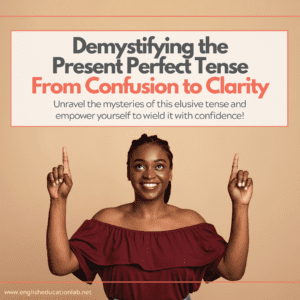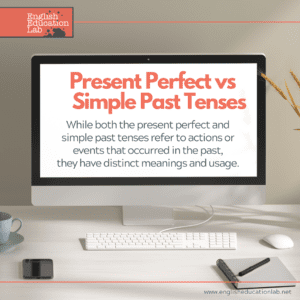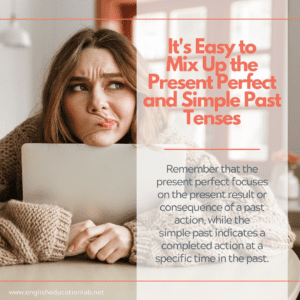
Demystifying the present perfect tense: From confusion to clarity
Welcome to the world of grammar, where confusion and clarity can sometimes seem like distant cousins. One such aspect of grammar that often leaves learners scratching their heads is the enigmatic present perfect tense (PP). But fear not! In this blog post, we will unravel the mysteries of this elusive tense and empower you to wield it with confidence.
 While its name might sound intimidating, understanding its purpose and usage can greatly enhance your communication skills.
While its name might sound intimidating, understanding its purpose and usage can greatly enhance your communication skills.
Throughout this post, I’ll demystify the PP, explore its various uses and provide clear examples to illustrate its application. I will also address common pitfalls and offer practical tips to help you master this grammar concept. So if you’ve ever felt perplexed by sentences like “He has already finished his homework” or “I have never been to Paris,” join me as we unpack the present perfect tense and make confusion a thing of the past. Let’s dive in!
Understanding the structure of the present perfect tense
The present perfect tense is formed by using the auxiliary verb (helping verb) “have” (in its different forms) followed by the past participle of the main verb. This structure remains consistent regardless of the subject of the sentence. For example, “I have eaten,” “You have eaten,” “He has eaten,” and so on.
The past participle of regular verbs is formed by adding “-ed” to the base form of the verb. For irregular verbs, the past participle can vary and must be memorized individually. For instance, the past participle of “go” is “gone,” and the past participle of “read” is “read.”
Common uses of the present perfect tense
The present perfecct has several common uses that reflect its versatile nature. Let’s explore these uses in detail:
1. Unspecified past actions or events: We use this tense when the time of the action or event is not specified or is not important. For example, “I have seen that movie,” which implies that the person has seen the movie at some point in the past without specifying when.
2. Actions or events that happened in the past but have a present impact: We use this tense to describe actions or events that started in the past and still have relevance or consequences in the present. For instance, “She has lost her keys,” which suggests that the person lost her keys at an indefinite time in the past and is still experiencing the consequences of that loss.
3. Actions or events that have occurred multiple times: We use this tense to express actions or events that have happened multiple times in the past. For example, “I have visited Paris three times,” indicating that the person has been to Paris on three separate occasions.
4. Actions or events that have just been completed: We use this tense to describe actions or events that have just been completed. For instance, “They have just finished their presentation,” implying that the presentation was completed very recently.
Differences between the present perfect and simple past tenses
While both the present perfect and simple past tenses refer to actions or events that occurred in the past, they have distinct meanings and usage.
The simple past tense is used to describe actions or events that happened at a specific time in the past and are now completed. It does not have a connection to the present. For example, “I ate breakfast this morning” or “She finished her work yesterday.” In these sentences, the action in the past has no connection to the present.

On the other hand, the PP tense focuses on the present result or consequence of a past action or event. It indicates that the action or event started in the past and has a connection to the present. For instance, “I have had breakfast,” which implies that the action of eating breakfast occurred at an indefinite time in the past but still has relevance now.
We are drawing attention to how a past action has influenced or shaped the current situation. In the case of having had breakfast, the emphasis is on the current state of having consumed breakfast and the potential impact it has on the person at the present moment.
One way to distinguish between the two tenses is to look for time expressions. The simple past tense is often accompanied by specific time expressions, such as “yesterday,” “last week,” or “in 2010.” In contrast, the present perfect tense is often used with time expressions like “already,” “yet,” or “never,” which indicate a connection to the present.
Understanding the differences between the present perfect and simple past tenses is crucial for using the PP tense accurately.
Examples of the present perfect tense in everyday conversation
The present perfect tense is frequently used in everyday conversation to describe various situations and experiences. Here are some examples to illustrate its application:
1. “I have lived in this city for five years.” This sentence indicates that the person has been living in the city for a period of five years and is still residing there.
2. “Have you ever tried sushi?” This question asks if the person has had the experience of eating sushi at any point in their life.
3. “She has already finished her homework.” This sentence suggests that the person completed their homework at some point before now.
4. “We have never been to Paris.” This statement conveys that the person has not visited Paris at any time in the past.
These examples showcase how the PP can be used to express various situations and experiences. However, it’s important to be aware of common mistakes to avoid when using this tense. Let’s discuss some of these mistakes in the next section.
Common mistakes to avoid when using the present perfect tense
While the present perfect tense may seem straightforward, there are some common mistakes that learners often make. Being aware of these mistakes will help you avoid them and use the PP accurately. Here are a few to watch out for:
1. Incorrect use of the past participle: Using the wrong form of the past participle can lead to grammatical errors. For example, saying “I have went” instead of “I have gone” is incorrect.
2. Confusing the present perfect with the simple past tense: It’s easy to mix up the PP and simple past tenses, especially when describing past events. Remember that the present perfect focuses on the present result or consequence of a past action, while the simple past indicates a completed action at a specific time in the past.

3. Incorrect use of time expressions: Using time expressions incorrectly or inappropriately can affect the accuracy of the PP. For instance, saying “I have already ate” instead of “I have already eaten” is incorrect.
4. Overusing the present perfect tense: While the PP is versatile, it should be used selectively. Overusing it can make your writing or speaking sound unnatural. It’s essential to consider the context and purpose of your communication.
By being mindful of these common mistakes, you can improve your accuracy when using the tense. In the next section, I’ll provide some practical tips to help you master this grammar concept.
Tips for mastering the present perfect tense
Mastering the present perfect tense takes practice and attention to detail. Here are some tips to help you enhance your understanding and usage of this grammar concept:
1. Read and listen to English materials: Exposing yourself to a variety of English materials, such as books, articles, and podcasts, will familiarize you with the usage of the PP in different contexts. Pay attention to how native English speakers use this tense in their conversations.
2. Practice with exercises: Engaging in targeted practice exercises can help solidify your understanding of the PP. Look for grammar workbooks or online resources that provide exercises specifically focused on this tense.
3. Seek feedback: Ask a native English speaker or a language tutor to review your written or spoken English and provide feedback on your usage of the PP. Their insights can help you identify any areas for improvement.
4. Use the present perfect tense in context: Incorporate the present perfect tense into your everyday conversations and writing. The more you use it in context, the more natural it will become for you.
5. Keep a grammar journal: Maintain a grammar journal where you note down examples of the PP that you come across in your reading or listening. Reflecting on these examples and analyzing their usage will deepen your understanding.
By following these tips, you can gradually master the present perfect tense and feel more confident in your English communication skills.
Additional resources for learning and practicing the present perfect tense
If you’re looking to further enhance your understanding and practice of the present perfect tense, here are some additional resources to explore:
1. Grammar books: There are numerous grammar books available that provide in-depth explanations and exercises specifically focused on the PP. My absolute favorite series is Raymond Murphy’s English Grammar in Use. For beginners: “Basic Grammar in Use” by Raymond Murphy, for intermediate learners: “English Grammar in Use” by Raymond Murphy and for advanced learners: “Advanced Grammar in Use” by Raymond Murphy.

2. Online grammar websites: Websites like Grammarly and English Grammar Online offer comprehensive explanations, examples, and exercises related to the PP. These resources can be accessed for free and provide interactive learning experiences.
3. Language learning apps: Apps like Duolingo and Babbel offer language courses that cover various aspects of grammar, including the PP. These apps provide a gamified learning experience and enable you to practice your grammar skills in a fun and engaging way.
Embracing the present perfect tense in your English communication
Congratulations! You have successfully navigated through the intricacies of the present perfect tense. By understanding its structure, differences from the simple past tense, common uses, and potential pitfalls, you are now much more equipped to wield this versatile grammar concept with confidence!
Remember, mastering the PP requires practice and exposure to authentic English materials. By incorporating the tips and exercises provided in this article, you can continue to improve your understanding and usage of this tense.
So embrace the present perfect tense and let it become a valuable tool in your English communication. From confusion to clarity, you have now demystified this enigmatic aspect of grammar. Happy communicating!
Get Your Free Cheat Sheet on Understanding the English Articles Here!
Get your Free Guide to Speaking English with Confidence- Your 5-Step Roadmap here!
Further Reading
How to train your brain to think in English
Level up your English job interview skills: Expert strategies for success
Why accent reduction matters in today’s globalized world
The top 10 ESL podcasts you need to listen to right now!
Small talk- Why it matters and how to master it


Transform your ESL lessons with TED Talks: Powerful teaching resources for ESL teachers

